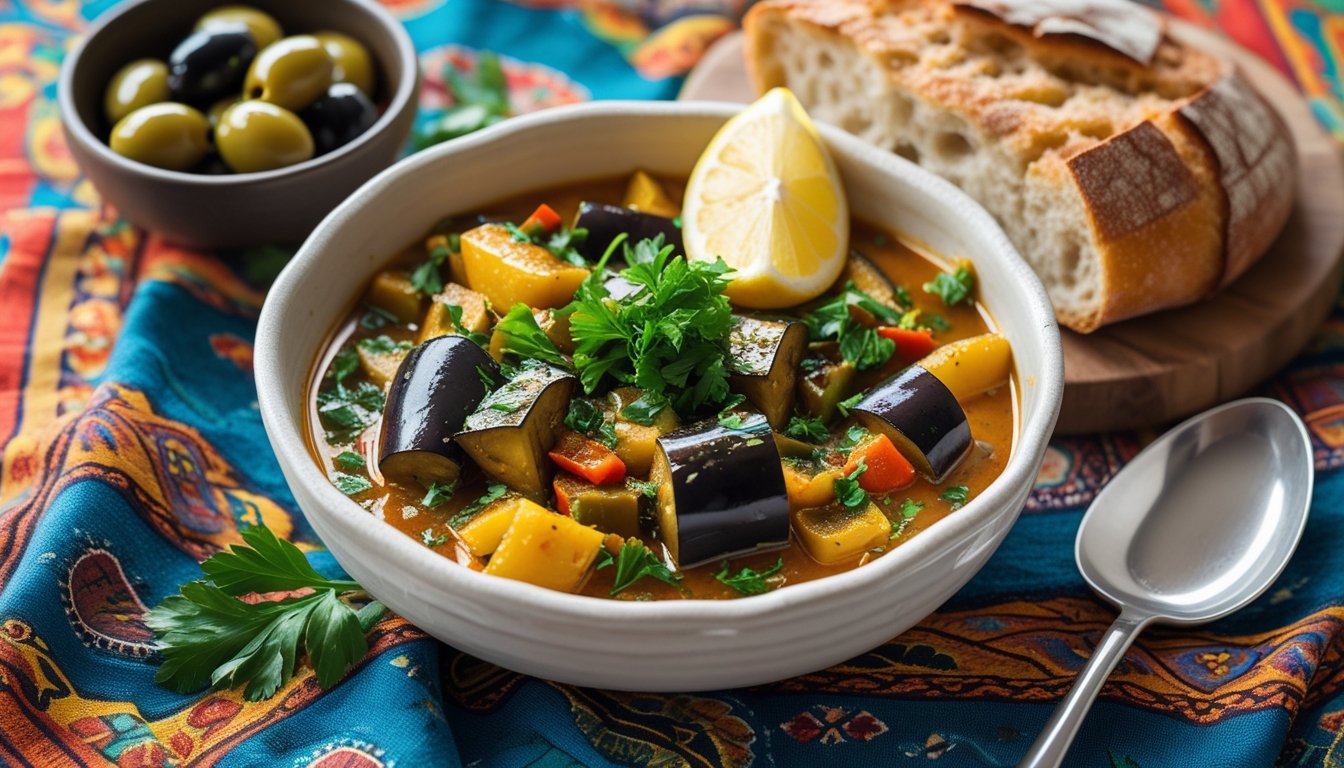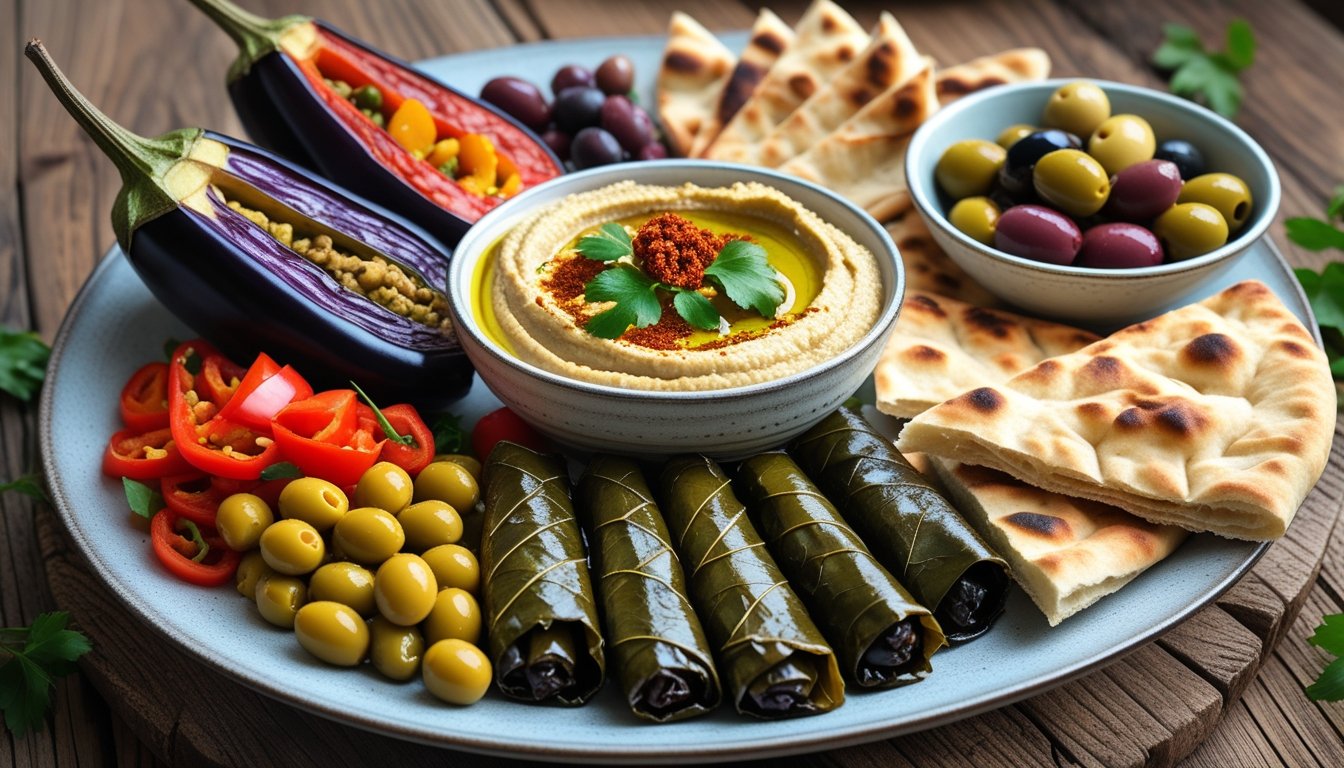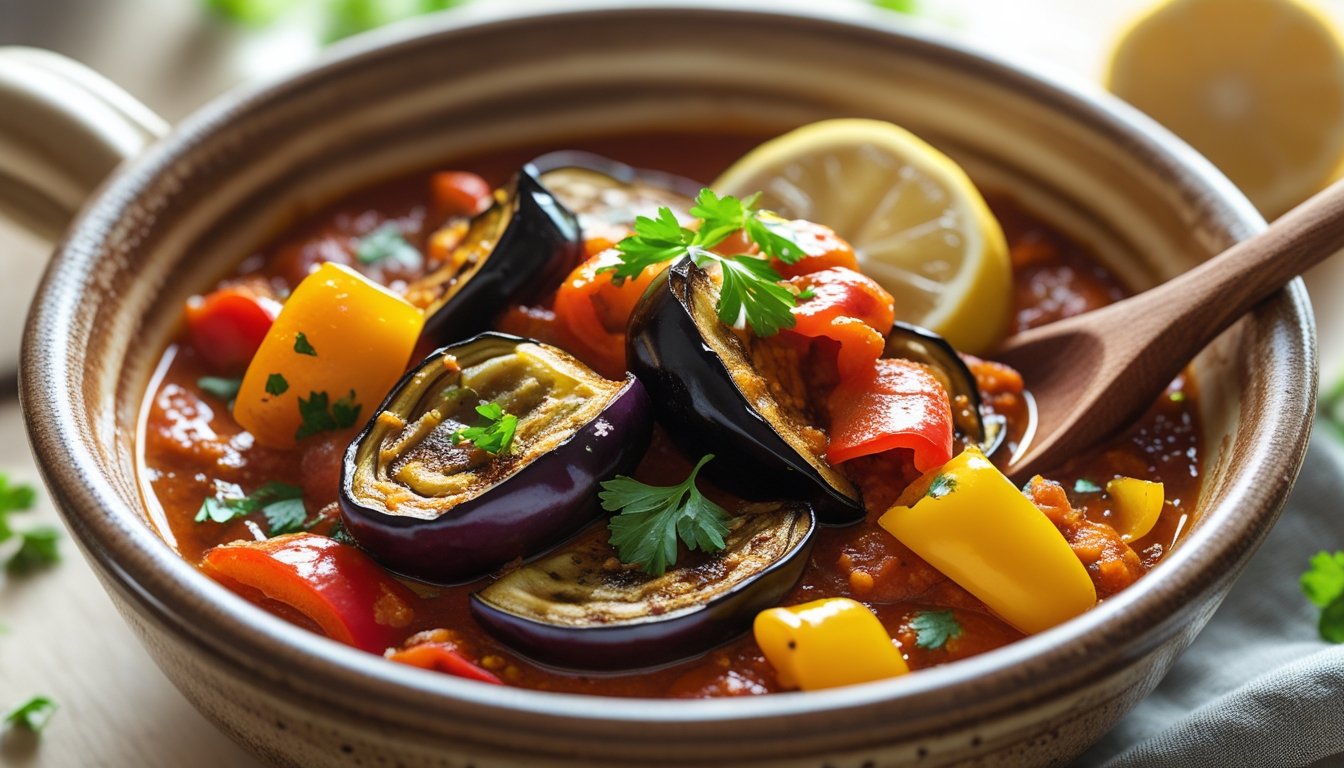Hey foodie friend! Ever stumbled across a dish that’s so simple yet so utterly addictive that you wonder how it’s not world-famous? Well, that’s Aubergine & Pepper Saksuka, a Turkish meze that had me hooked from the very first bite. Seriously, this isn’t just a side dish—it’s like a little Mediterranean vacation on your plate.
I remember the first time I tried Saksuka during a summer trip to Istanbul. Picture this: the sun warming the cobbled streets, the distant calls of market vendors, and the smell of roasted vegetables mingling with garlic and spices.
There it was, on a small ceramic plate, a vibrant mix of aubergines and peppers swimming in a rich tomato sauce. I was skeptical at first—eggplant, really? But one bite, and I was completely sold. Since then, I’ve spent countless hours perfecting my version, and trust me, this one is a keeper. Whether you’re looking to impress guests or just spice up your weeknight dinner, this dish delivers every single time.
So, let’s get comfy and dive deep into why this dish is so special, how to make it perfectly, and how to serve it like a Turkish pro.
o make this dish, start by washing and chopping your aubergines into cubes and slicing bell peppers. Sprinkle the aubergines with salt to remove bitterness and let them sit for a few minutes before patting them dry. Roast the aubergines in olive oil until golden and soft, then add the peppers and cook until slightly charred for that smoky flavor.
Meanwhile, prepare the tomato sauce by sautéing finely chopped onions and garlic in olive oil until fragrant. Add fresh or canned tomatoes along with paprika, chili flakes, salt, and pepper, then simmer until thickened. Combine the roasted vegetables with the sauce and let them simmer together for a few more minutes, allowing the flavors to meld. Finish the dish with fresh parsley and a squeeze of lemon for brightness and freshness.
Serve Aubergine & Pepper Saksuka as part of a meze platter, alongside grilled meats, or over rice for a complete meal. This dish is simple to prepare yet packed with flavor, making it a must-try for anyone who loves Turkish cuisine. The complete recipe is given below for step-by-step guidance.

What Makes This Turkish Meze Special
Saksuka is a staple in Turkish cuisine, and for good reason. Think of it as the appetizer level, but leveled up with rich flavors and textures. Unlike simple dips or spreads, Saksuka combines soft, melt-in-your-mouth aubergines with sweet, slightly smoky peppers in a vibrant tomato sauce. The flavors balance beautifully: the richness of the eggplant, the sweetness of the peppers, and the tang of tomatoes all create a symphony for your taste buds.
Here’s what makes it stand out:
- Flavor depth: Roasted vegetables give a caramelized, smoky undertone that just screams homemade love.
- Versatility: Serve it hot, warm, or cold—it’s delicious any way.
- Nutrient-rich: Eggplants are packed with fiber, vitamins, and antioxidants, while peppers add extra vitamins and a pop of color.
Ever wondered why simple ingredients often create the most unforgettable dishes? This is the perfect example. Sometimes, keeping it simple is the secret to culinary brilliance.
Ingredients You’ll Need (And Why They Matter)
Let’s talk ingredients. The best part is you don’t need a crazy list of obscure items—just fresh, quality produce and a few pantry staples.
Fresh Veggies
- 2 medium aubergines (eggplants) – Look for firm, shiny ones without soft spots. Texture is key; mushy eggplants are a nightmare.
- 2-3 bell peppers – Red, yellow, or orange. Mixing colors makes the dish visually stunning, like a little veggie rainbow.
- 1 medium onion – Finely chopped; this forms the base of your sauce and adds natural sweetness.
Sauce Essentials
- 3-4 ripe tomatoes – Fresh is best, but canned crushed tomatoes work in a pinch.
- 3 cloves garlic – Minced for a fragrant punch. Don’t underestimate garlic; it’s a game-changer.
- 2 tablespoons olive oil – Invest in quality olive oil; it really elevates the dish.
- 1 teaspoon paprika – Smoky paprika adds depth.
- ½ teaspoon chili flakes – Optional for heat; adjust based on your tolerance.
- Salt & pepper – To taste, obviously.
Optional Finishing Touches
- Fresh parsley – Chopped for a burst of color and freshness.
- A squeeze of lemon – Balances the richness of the vegetables beautifully.
Pro tip: Roast the aubergines and peppers before mixing them with the sauce. This step intensifies their flavor and creates that signature silky texture Saksuka is known for.
Step-by-Step Cooking Guide
Okay, now comes the fun part: actually cooking it. I’ve broken down every step into long, detailed paragraphs so you’ll know exactly what to do and why it works.
Step 1: Prepare Your Veggies
Start by washing all your vegetables thoroughly. The aubergines should be sliced into bite-sized cubes; this ensures they cook evenly and absorb the sauce beautifully. Slice the peppers into strips or chunks, keeping them roughly the same size as the aubergine cubes for even cooking. Chop the onion finely—don’t rush this step; a well-cooked onion adds a natural sweetness that balances the tang of the tomatoes later.
Here’s a little trick: sprinkle the aubergine cubes with salt and let them sit for 10-15 minutes. This step helps remove any bitterness and prevents them from becoming soggy when cooking. Rinse lightly and pat dry with a paper towel. It’s a small step, but it makes a huge difference in texture and flavor.
Step 2: Roast the Aubergines
Heat a generous 2 tablespoons of olive oil in a large skillet over medium heat. Once hot, add the aubergine cubes. Don’t overcrowd the pan—if they’re too squished together, they’ll steam instead of roast, and we’re aiming for caramelized, golden-brown perfection here. Sauté the cubes slowly, stirring occasionally, until they develop a deep golden color.
This step is where the flavor magic happens, as roasting brings out the natural sweetness of the aubergine while giving it a silky texture that melts in your mouth.
Step 3: Roast the Peppers
Once the aubergines are beautifully caramelized, add your bell peppers to the same pan. Cook them until they’re soft but still hold their shape, allowing them to get slightly charred edges. This charring adds a subtle smokiness to the dish that makes it extra irresistible. While it might be tempting to rush this part, patience is key—letting the peppers roast properly is what gives Saksuka its signature flavor.
Step 4: Make the Sauce
In a separate pan, heat a little more olive oil and sauté the finely chopped onion until it’s translucent and soft. Add the minced garlic and cook for another 1-2 minutes, stirring constantly to prevent burning. Then, add the chopped tomatoes, paprika, chili flakes (if using), salt, and pepper.
Reduce the heat slightly and let the sauce simmer for 10-15 minutes, stirring occasionally until it thickens slightly. This slow cooking allows the flavors to meld together, creating a rich, tangy base that perfectly complements the roasted vegetables.
Step 5: Combine and Simmer
Carefully add the roasted aubergines and peppers to the tomato sauce. Stir gently to combine, ensuring that all the veggies are coated in the sauce. Let everything simmer together for an additional 5-10 minutes.
This allows the flavors to mingle and the vegetables to absorb the sauce, giving you that satisfying depth of flavor that Saksuka is known for. Taste and adjust seasoning if needed. Sometimes a pinch of extra salt or a tiny dash of chili flakes can take it from good to unforgettable.
Step 6: Garnish and Serve
Finally, finish your dish with a sprinkle of fresh parsley and a squeeze of lemon juice. The parsley adds a burst of freshness and color, while the lemon balances the richness of the sauce. Serve your Aubergine & Pepper Saksuka in a shallow bowl with crusty bread for dipping or as part of a larger meze platter. The dish works wonderfully hot, warm, or even chilled—leftovers are often even better the next day as the flavors continue to develop.
Serving Suggestions and Pairings
Here’s where your creativity can shine. Saksuka is incredibly versatile, and you can serve it in a variety of ways:
- As part of a meze platter: Combine with hummus, stuffed grape leaves, olives, and feta for a full Turkish experience.
- With grilled meats: Chicken, lamb, or beef skewers pair beautifully with the rich, saucy vegetables.
- Over rice or couscous: Turn it into a hearty main dish by serving it over grains.
- Cold as a salad: Leftover Saksuka works as a refreshing cold dish, perfect for picnics or potlucks.
I love serving it at room temperature during casual dinner parties. Guests always ask for seconds, and I have to resist telling them the secret is just roasted aubergines and a lot of love.

Tips, Tricks & Common Mistakes
Even the best cooks can slip up, so here’s some advice:
- Never skip roasting: Boiled or steamed aubergines are sad aubergines. Roast or sauté for flavor and texture.
- Balance is key: Taste constantly; too much tomato can overpower, too little can be bland.
- Use fresh garlic: Jarred minced garlic just doesn’t cut it. Fresh garlic gives that punchy flavor.
- Don’t overcook peppers: They should remain tender but slightly firm; mushy peppers are a no-no.
- Make ahead: Saksuka tastes even better after a few hours as the flavors meld together.
If someone claims they don’t like aubergine, gently question their life choices.
Fun Variations
Want to make it your own? Here are a few ideas:
- Add feta cheese: Crumble some on top for a creamy, salty boost.
- Spicy twist: Dice up a chili or add hot paprika for extra heat.
- Herbal boost: Toss in fresh dill or mint for a fresh aroma.
- Nutty flavor: Toasted pine nuts add crunch and richness.
Each variation gives the dish a slightly different vibe—perfect for experimenting.

Why You’ll Love Making This
Honestly, this dish is a winner for several reasons:
- Ridiculously satisfying: Feels fancy, but easy to make.
- Healthy yet indulgent: Full of vegetables but tastes rich and flavorful.
- Flexible: Hot, cold, or room temperature—you choose.
- Shareable: Friends and family will fight over the last spoonful.
If you want a dish that’s fun to make and impossible to resist, Saksuka is your answer.
Conclusion
There you have it: a foolproof, flavorful, and utterly irresistible Aubergine & Pepper Saksuka recipe. From the silky roasted aubergines to the smoky peppers and tangy tomato sauce, it’s a dish that delivers on every level. Garnish with parsley and lemon, serve it with bread or as part of a meze platter, and watch it disappear in minutes.
Next time you’re craving something delicious and a little exotic, remember Saksuka. It’s simple, impressive, and totally worth the time. Roast those veggies, simmer that sauce, and enjoy a little slice of Turkish magic in your own kitchen. Your taste buds will thank you, and maybe even demand a repeat performance.
Frequently Asked Questions (FAQs)
What is Aubergine & Pepper Saksuka?
Aubergine & Pepper Saksuka is a traditional Turkish meze made from sautéed aubergines (eggplants) and bell peppers, simmered in a rich, spiced tomato sauce. Often enjoyed as part of a meze platter, it can also serve as a side dish or a light main course. The dish is typically served at room temperature, allowing the flavors to meld beautifully.
How do I prepare the aubergines before cooking?
To reduce bitterness and improve texture, sprinkle the diced aubergines with salt and let them sit for about 15 minutes. This process draws out excess moisture. Afterward, rinse them under cold water and pat dry with a paper towel before cooking.
Can I use other vegetables in Saksuka?
Absolutely! While aubergines and peppers are traditional, you can incorporate other vegetables like zucchini, potatoes, or tomatoes to suit your taste. The key is to maintain a balance of flavors and textures.
Is Saksuka spicy?
The level of spiciness in Saksuka depends on your preference. The base recipe includes mild spices, but you can adjust the heat by adding chili flakes or fresh chilies to the tomato sauce.
How do I store and reheat leftovers?
Store any leftover Saksuka in an airtight container in the refrigerator for up to 3 days. To reheat, gently warm it on the stovetop over low heat, adding a splash of water or olive oil if needed to restore its consistency.
Can I make Saksuka ahead of time?
Yes, Saksuka often tastes even better the next day as the flavors have more time to develop. It’s an excellent dish for meal prepping or preparing in advance for gatherings.
What should I serve with Saksuka?
Saksuka pairs wonderfully with crusty bread, pita, or lavash for dipping. It also complements grilled meats, rice pilaf, or other meze dishes like hummus and tzatziki.
Is this recipe suitable for vegetarians or vegans?
Yes, the traditional version of Saksuka is both vegetarian and vegan, making it a versatile option for various dietary preferences.

